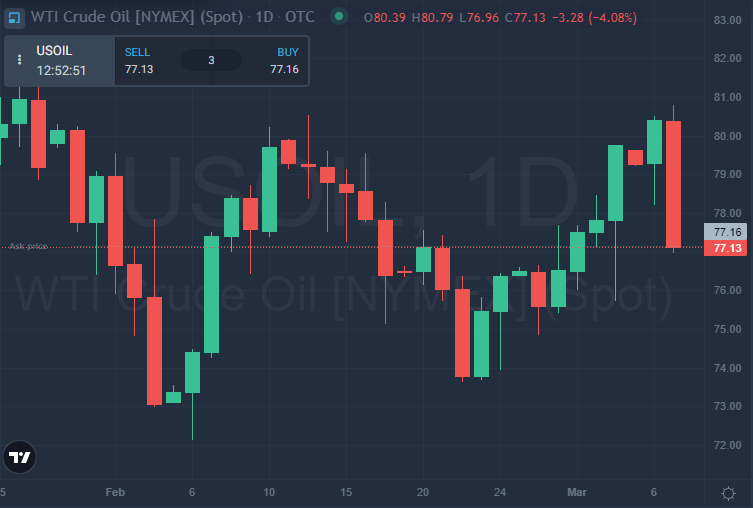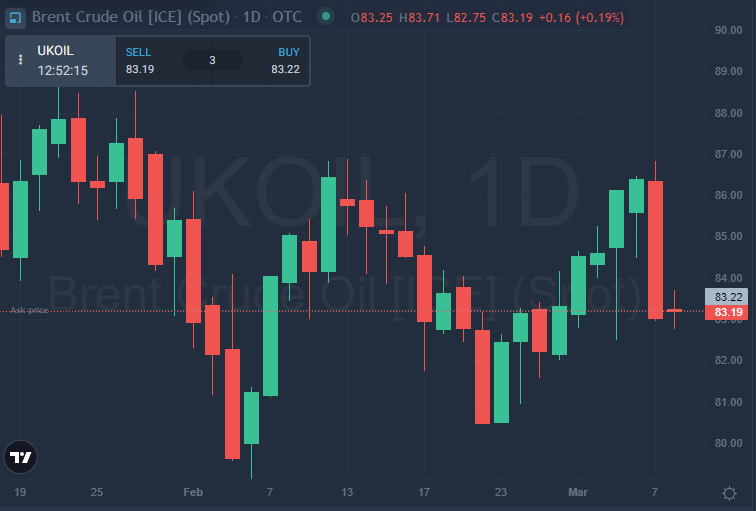Despite the restrictions, JP Morgan Bank doubts cutting Russian oil production to 500,000 barrels a day. Russia even increases demand from countries like India and China.
Table of contents:
Cutting Russian Oil Production At 500k Daily
JP Morgan Bank assessed on March 2 that Russia is doing well in the oil market despite the sanctions on oil exports in force since December 2022. „We believe Russia will be able to maintain its oil production at pre-war levels of 10.8 mbd (million barrels a day) but will have difficulties getting back to peak pre-COVID volumes of 11.3 mbd.” said the Bank.
Recall that as part of the sanctions:
- The European Union stopped buying oil from Russia by sea (transport by pipelines is allowed),
- Europe, the US, and countries supporting Ukraine have set an upper limit on the price of a barrel of Russian oil at $60.
In response to these restrictions, Russia announced cutting oil production starting in March. The market reacted strongly to the news of a drop in oil supply as investors feared that crude oil prices would increase, adding to inflation.

Unafraid Recipients Increase
On the other hand, JP Morgan publicly announced his doubts about cutting Russian oil production. It argues that he doesn’t because he doesn’t have to. The bank expects the restrictions will only apply in March, and everything will return to normal in April. According to JP Morgan, Russia can sell as much oil as usual because it has more and more recipients who are unafraid of and avoid sanctions.
Read also: US-China Microchips War
India and China: Growing Demand
It’s about India and China. According to JP Morgan, the total demand for oil from these countries will increase by more than a million barrels a day this year. They will likely buy it from Russia, which offers much cheaper crude. This is an opportunity for India and China to save money, mainly because the countries are not part of the coalition supporting Ukraine in the war with Russia.
And in fact, India is breaking records for purchasing Russian oil. It is worth noting that it is increasing exports of finished petroleum products to Europe and the United States. In February 2023, Indian refineries processed about 1.9 million barrels of Urals oil daily. This is more than the record 1.4 million barrels per day in January and significantly higher than the 1.2 million barrels per day in December 2022. JP Morgan expects oil demand in India and China to increase by 1 million.
Read also: How to Trade Economic Events. We’ll Let You Know When They Arrive
Gulf States Defy US Sanctions
We will likely face a scenario in which there will be no oil from Russia in Europe. At the same time, more raw materials will go to Asian countries and even right up to the nose of Americans. For example, recently, there was information that the head of Rosneft visited Cuba. So it is very likely that Russia will find another client.
Additionally, as reported by Reuters, commercial sources and ship tracking data have shown that the UAE is accepting an increasing number of cargoes of Russian oil. Recall that the Gulf states resisted pressure from the US, which wanted to include them in a coalition that isolated Russia. The Americans have pressed the Gulf countries to pump more oil to replace Russian supplies after the sanctions are imposed. There is also growing cooperation between Russia and top oil producers in the Persian Gulf, such as Saudi Arabia and the United Arab Emirates.

Sanctions: Leaky Or Effective?
What do the doubts about cutting Russian oil production tell us? On the one hand, it shows us that Western sanctions are leaky. On the other hand, thanks to leaky sanctions, we avoid increasing fuel prices at petrol stations.
Read also: How to Manage Risk When Trading
No matter how bad we feel about it, fuel prices have stayed the same because Russia gets around the sanctions. UKOIL has been trading at $80-90 a barrel since mid-November. The spread between the price of Brent crude oil (UKOIL) and Russian Urals crude oil has recently narrowed to $30, and the price of Urals oil has increased to $56. However, this is still a relatively low price, so in this sense, the sanctions work – Russia has to sell oil at underpriced prices.
Read also: How to Trade Market Sentiment

